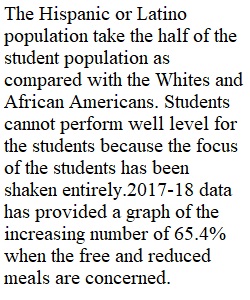


Q After reviewing both charts and tables and filtering the data by number, percentage, and sub-groupings (where available): What can you infer about the Riverside Unified district in terms of student population? In terms of district mobility, given differences between the Census Enrollment and Cumulative Enrollment? What can you conclude from a comparison of the 2017–2018 Free and Reduced-Price Meals; Unduplicated Pupil Count of Free/Reduced-Price Meals, English Learners & Foster Youth; and English Learners? What other inferences can be made from the Riverside Unified District demographic data? Click also on the Performance bar near the bottom of the page to locate the ELA, mathematics, and fitness performance results. Be sure to filter your results by different sub-groups to see similarities and differences. What are 3–5 conclusions you might draw from the data tables and charts? What questions would you ask to gain clarity about some of the conclusions suggested but not verified by the data? What are some of the inherent limits to what you can infer from this type of quantitative data?
View Related Questions